Jan Magnussen: The Motor Sport Interview
A promising start brought comparisons with Ayrton Senna but it was away from Formula 1 that Jan Magnussen made his mark. Here, the Le Mans regular lifts the lid on his highs and lows
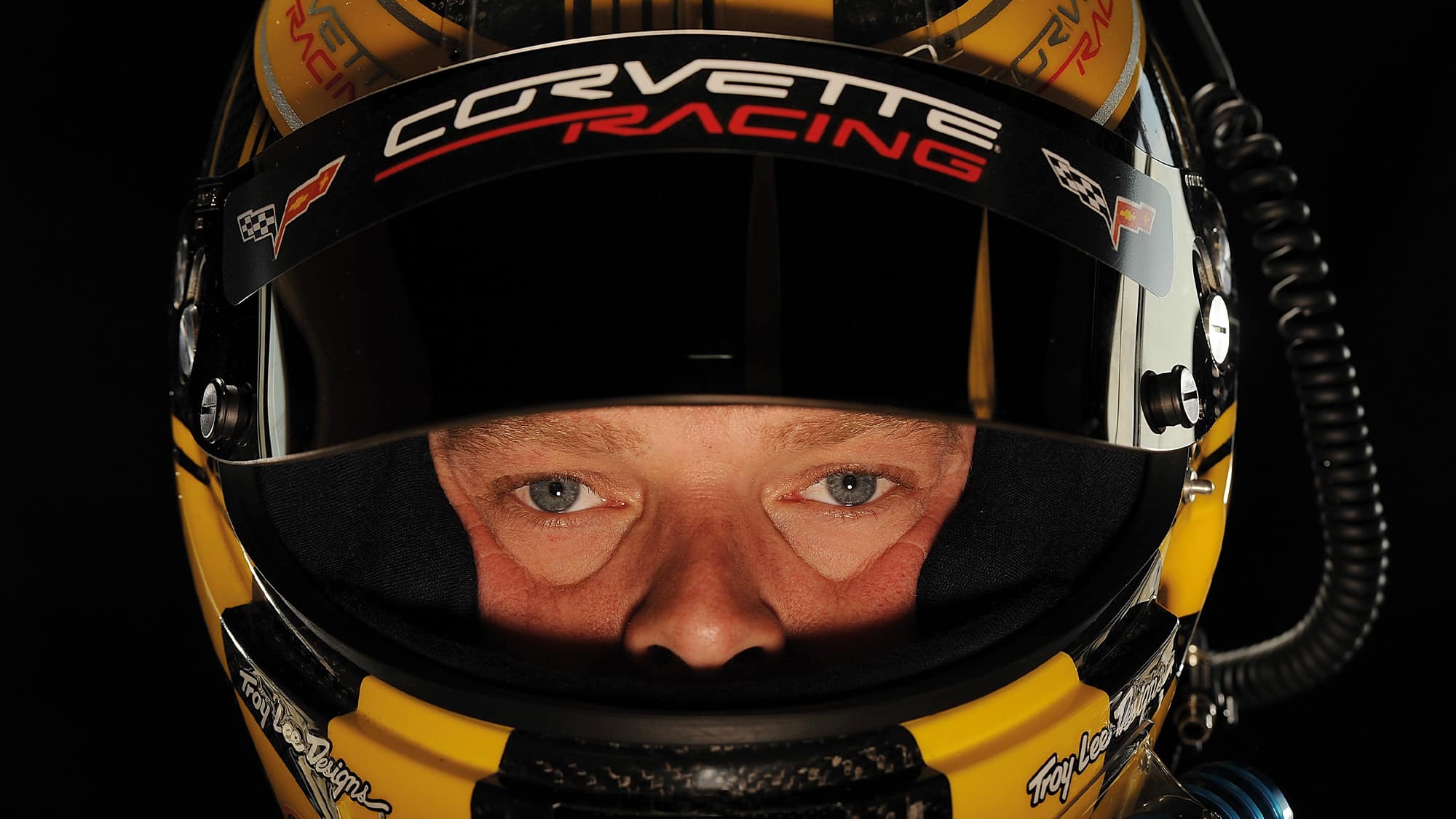
Getty Images
Jackie Stewart described Jan Magnussen as “the greatest driving talent to emerge since Ayrton Senna”. The young Dane dominated the 1994 British F3 championship, winning 14 of 18 races for the Paul Stewart team. As a teenager he’d already won the ultra-competitive Formula Ford Festival, his destiny as a future Formula 1 world champion seemingly assured.
He made his F1 debut for McLaren at the Pacific Grand Prix in October 1995 but the dream career was diverted across the Atlantic for 1996. Jan stood in for both Paul Tracy and Emerson Fittipaldi in Penske’s CART team after both were badly hurt in accidents. Then came the big chance to prove himself with the Stewart Grand Prix team alongside Rubens Barrichello for 1997.
To this day people are still mystified why it ended, not with a championship, but by being replaced by Jos Verstappen halfway through 1998. Talking to Motor Sport from his home in Roskilde, this immensely likeable Dane looks back on his time in F1 and tells us, in typically honest fashion, how he rebuilt his career in America.
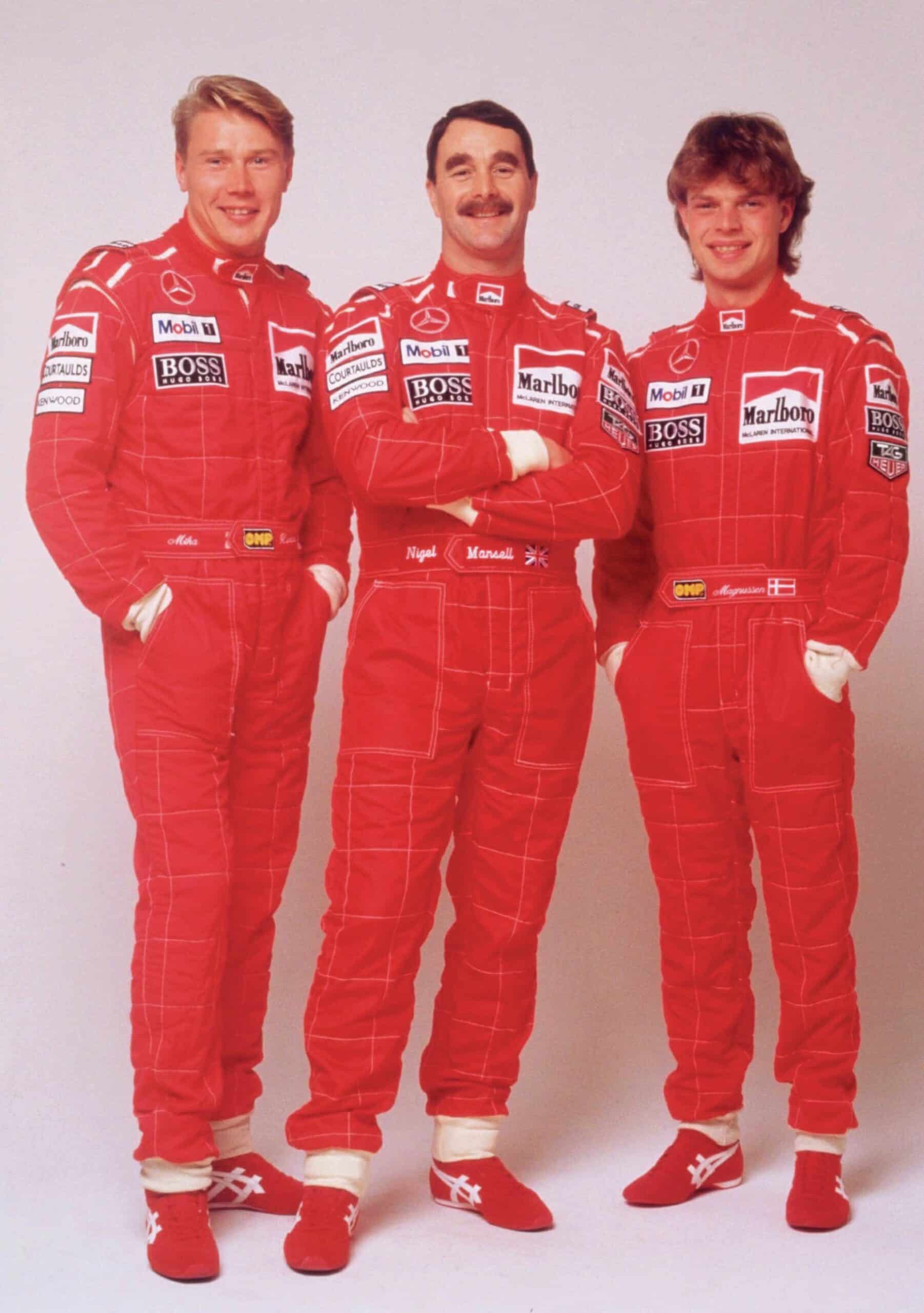
McLaren test driver Magnussen, right, covered for the appendicitis-stricken Mika Häkkinen, left, at the Pacific GP in 1995. Nigel Mansell bowed out from F1 this season, appearing twice
Shutterstock
Motor Sport: You came to England as a teenager, won the Formula Ford Festival in 1992, by which time you were also a father at just 19. Everyone was talking about you. It all seemed so easy.
JM: “Well, yes… and no. I knew I had the speed and the talent in the car but it was still early days and there was very little money. I’d already won three Kart World Championships, two junior and one senior, so I knew I had to come to England and get myself into a Formula Ford. I’d had some support at home from Team Denmark, who helped young athletes, but it was very small money and racing at home was really only at club level.
“I don’t want to sound big-headed but I knew I had talent”
“I felt confident I would be competitive in England. My son Kevin [who would go on to race in F1 for McLaren and Haas] was born just before the Formula Ford Festival in October ’92 and it was pretty difficult balancing the racing with being a father so young, a lot of pressure. Looking back it was not the greatest situation but I’m so happy it happened that way. I’d go home and spend time with him when there was no racing. It was harder than I thought it was going to be but I learnt so much and won seven of the last nine races of ’92 including the Festival and that led to Formula Vauxhall and Opel in ’93, including a couple of races with Paul Stewart’s F3 team.”
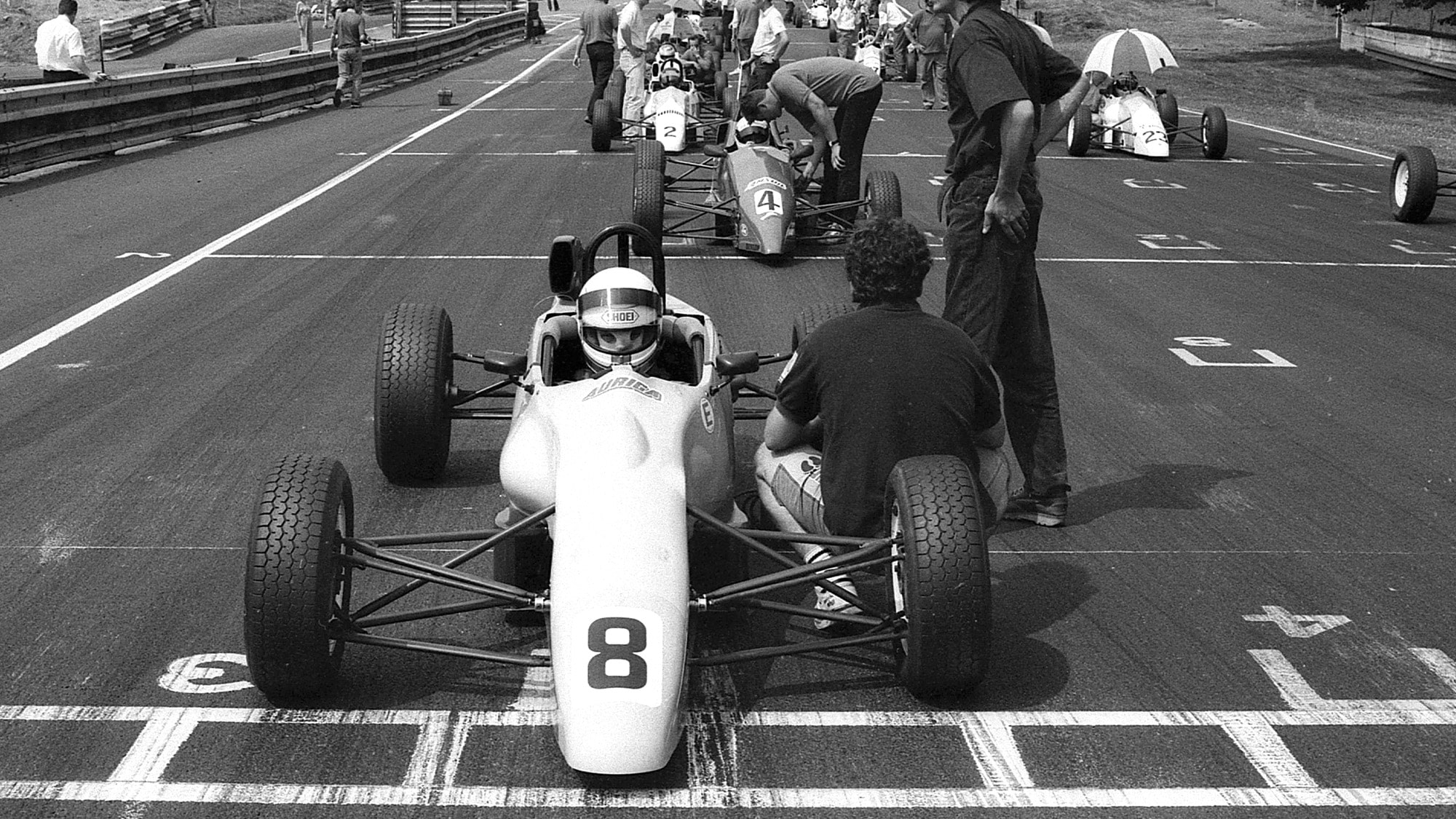
On the grid at Oulton Park in 1992 in the Formula Ford Van Diemen RF92
Alamy
Your F3 season with Stewart in ’94 was extraordinary, winning 14 of the 18 races, setting new records, and Jackie Stewart declared that you were the greatest driving talent since Ayrton Senna.
JM: “Yeah, people around me were saying these things and I started to believe it myself. And yet, you know, in some ways it didn’t do me a lot of favours because it all came to me so easily, so naturally. It wasn’t something I had to work at. I thought this was how my whole career was going to be. Maybe too much success so soon, but Jackie Stewart was always very supportive. Not everything he did was right for me, but he tried. I was a smoker then, not fit enough, and he tried to point me in the right direction. I had a lot of respect for him and for what he had achieved before I was even born. It was a good team, we gelled well together, but I didn’t have a great working relationship with Paul Stewart and later on that probably went against me. That aside, right then, at the end of ’94, I really felt there were no limits. I don’t want to sound big-headed but I knew I had the talent.”
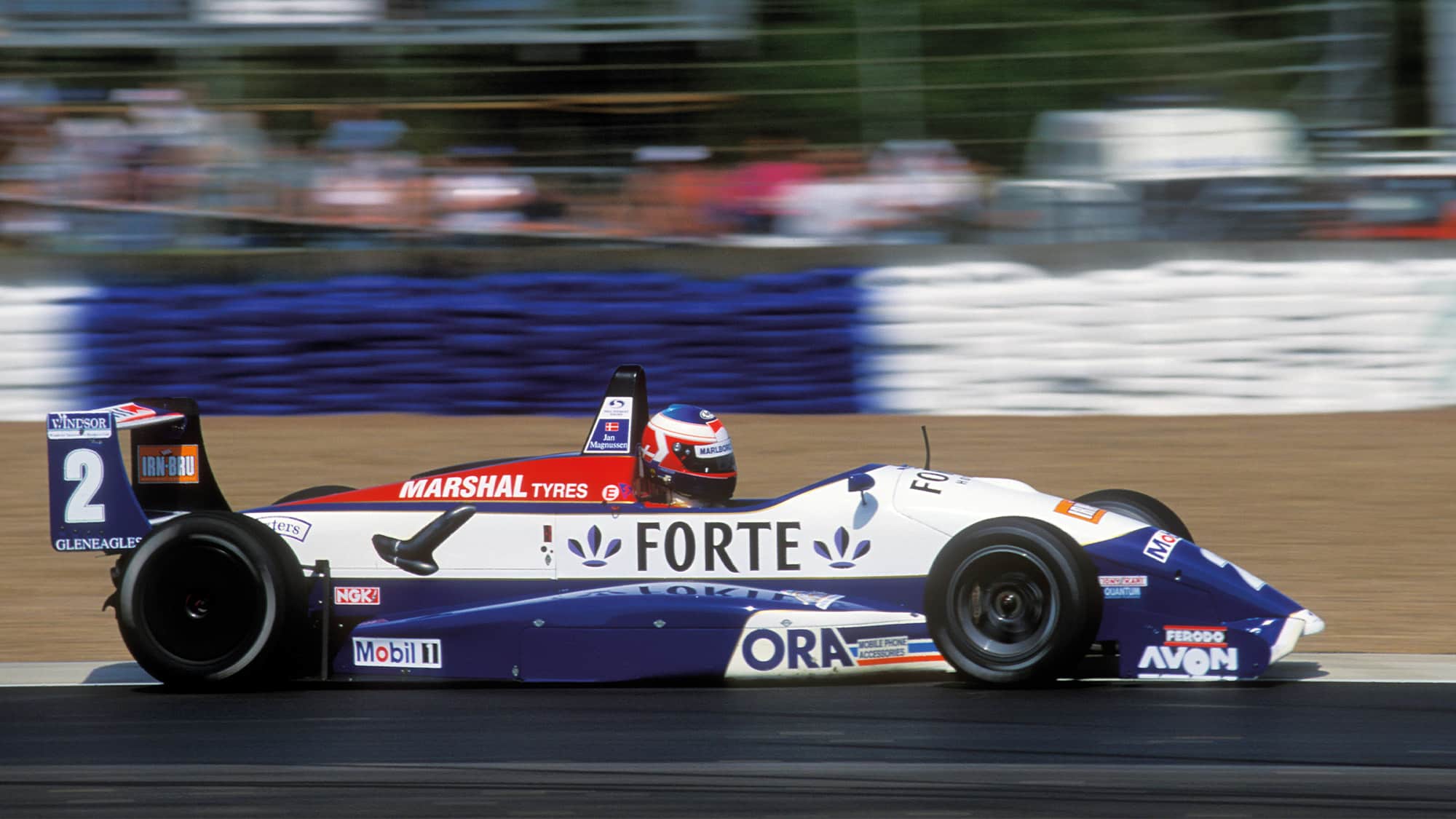
Driving for Paul Stewart Racing, Magnussen stormed British F3 in 1994
Grand Prix Photo
That F3 title brought you a testing contract with McLaren and DTM racing with Mercedes for ’95. At the Norisring you had your first real setback, crashing your scooter and breaking a leg.
JM: “That was really horrible. My manager was on the back and she was very badly hurt. We came out of the track, on the way back to the hotel, and I drove straight out into the main street and was hit by a car. It was bad, but I wasn’t out for that long. I was testing 11 days later. The year after, again at the Norisring, I had a huge crash when a brake disc exploded and that did me a lot more harm mentally. A big accident like that will happen and you have to get over it, get back in the car.
“Those DTM cars were fantastic, the coolest cars I ever drove and I had two wins. There was big money involved, some politics of course, and I wasn’t on the best team.”
The McLaren test contract was, on paper, a huge opportunity but it didn’t deliver as much as you hoped. Just one race, at the end of ’95, standing in for an unwell Mika Häkkinen in Japan. What went wrong?
JM: “It’s not so simple. Ron Dennis and I were such completely different people. We had some awful meetings. He would say I was disorganised, not focused enough, and yeah, with hindsight, maybe I let myself down. I should have been fitter and been better organised that year. McLaren wasn’t the same then as the team we see now. I think it’s more open today, more supportive of young drivers. I probably should have stayed there to keep learning but it was a test contract and I wanted to race. The idea was to get me up to speed in an F1 car, to be ready to race one day, so I was just doing very short runs in testing, in and out, giving some feedback. The longest run I ever did was four laps and then, on the Sunday before the race in Japan, I was told I’d be doing the Grand Prix.
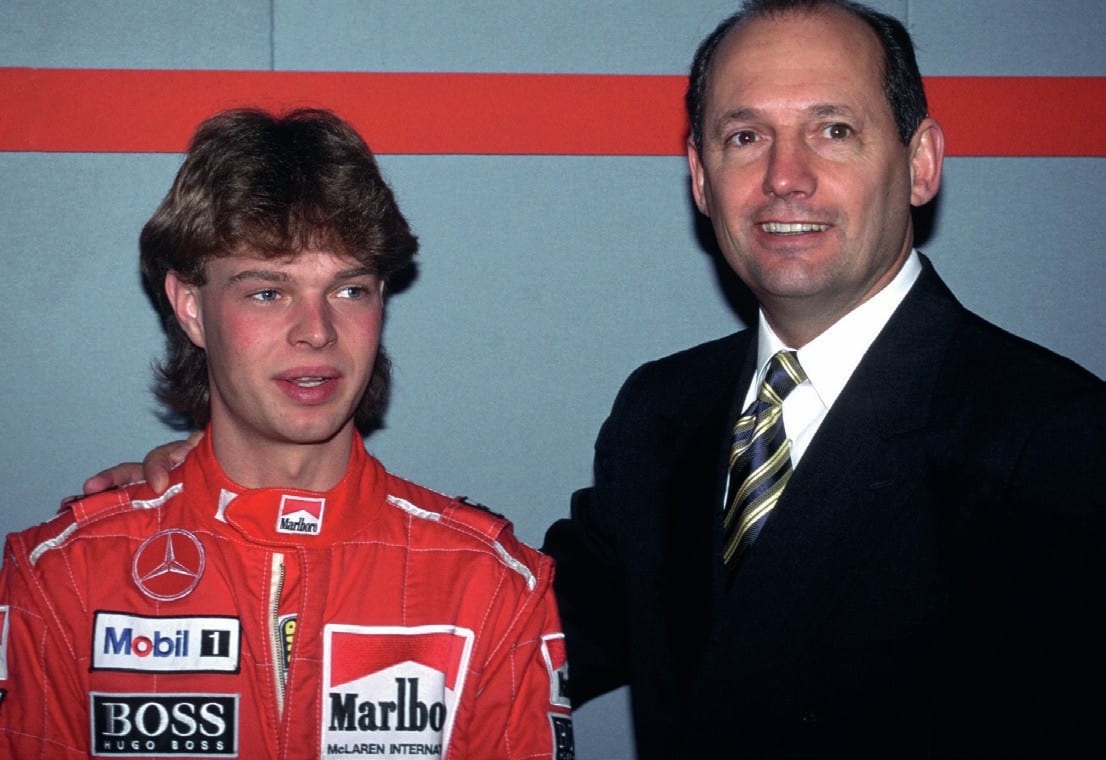
Ron Dennis with McLaren’s young hope, but the team boss was less than impressed
Grand Prix Photo
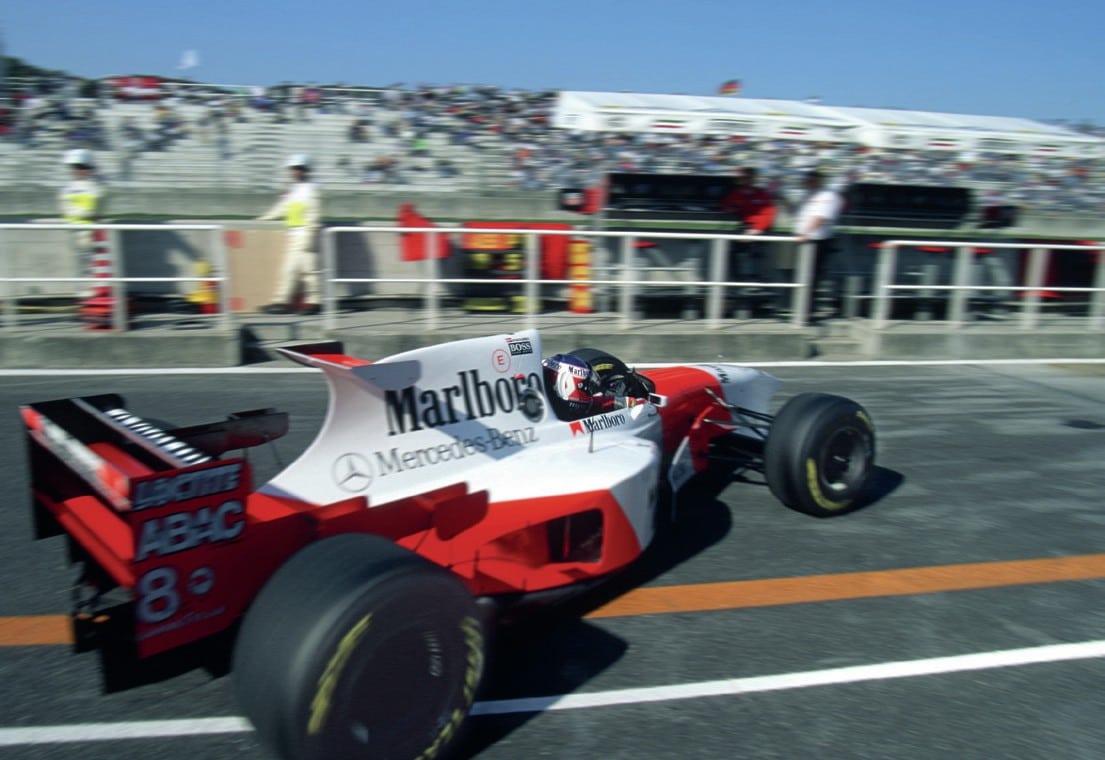
Tension at his F1 debut in 1995
Grand Prix Photo
“There was no time to prepare, just some practice starts and pit box entries and off to Japan. It was a very stressful week, a real mouthful, but the guys did everything they could to keep me calm, give me space to get myself ready. I finished 10th, just behind my team-mate Mark Blundell. I could have passed him but I wanted to be seen as a safe pair of hands, not run into him, but I should have had a go and passed him. Ron Dennis asked me afterwards why I hadn’t tried a bit harder. He wasn’t impressed.
“After that, in ’96, McLaren did a deal for me to race for the Hogan Penske IndyCar team, standing in for Paul Tracy after his Michigan accident and also for Emerson Fittipaldi after his big accident. I liked the American racing scene very much, the more relaxed atmosphere. But at that time… I was still very keen to succeed in Formula 1 and I was quite verbal about it, so that closed any doors that might have opened for me over there. I didn’t show IndyCar the respect
I should have done but the cars were great to drive, very powerful, and much more mechanical than an F1 car.”
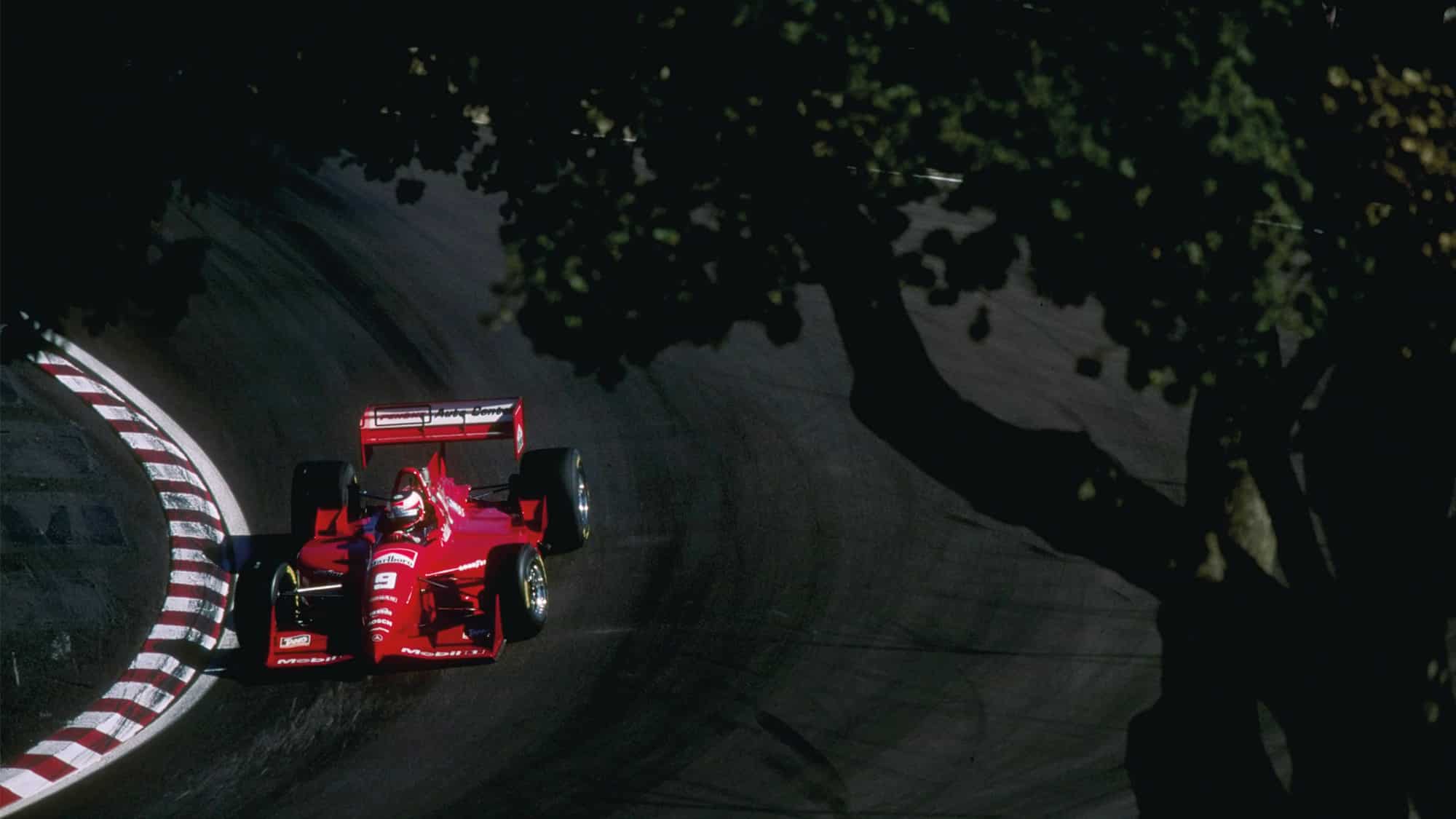
Injury replacement at Hogan Penske in 1996 brought IndyCar experience
Getty Images
Now comes your best chance to prove yourself in Formula 1 with Stewart Grand Prix in 1997 alongside Rubens Barrichello. Can you explain why this opportunity delivered so little?
JM: “Aaaah, well, so many things, you know. First, the biggest mistake I made was relying on what I perceived to be my natural talent. Driving, racing, came so easily to me but Formula 1 was just so tough, and working in a way that I didn’t fully understand at the time. In F3 the team was always right behind me. All those victories were theirs as much as mine, and I thought it would be the same in F1. But it’s such a tricky business and I didn’t identify where I needed to work harder until it was too late. I didn’t feel the team was always supporting me. There were clauses in the contract, like if there were new parts for the car they would go to Rubens. I thought, ‘Okay, if I am slower than him, the team must realise why,’ but it didn’t work like that. The team was constantly developing in ’97 and the upgrades went to Rubens with whom, I have to say, I always had a really good relationship. We were proper friends, and that’s the biggest positive I took away from my F1 career.
“It was over, we were done, and that did my head in for six months“
“The car itself was pretty decent in ’97, but we had so many engine problems, so many retirements. When things keep failing you just don’t get enough laps in the car and I needed time to gain my confidence. In ’98 the car was better, the engine was more reliable, but then we started having gearbox gremlins, and it was the first year of the grooved tyre so I had to re-learn everything. Formula 1 is not always the right place to be for every racing driver, however quick or talented he may be. The chances of the right car at the right time are very slim. It looked good for Kevin [Magnussen] when he went to Haas but at the end I think money became more important than talent for the team.”
Despite the problems at Stewart Grand Prix, Jackie himself had high hopes for you and gave you a four-year contract. How helpful was he when your career clearly wasn’t going to plan?
JM: “He tried to help me but not everything he did was right for me, like his driving lessons. That pissed me off. He took me to Oulton Park with a Ford Escort, for him to show me how to drive, but that wasn’t where I needed help, and not in a Ford Escort. That was not a good day. Jackie tried to help me get my mind around things in the right way for Formula 1, point me in the right direction, but by then it was too late. In fact I was getting much closer to where I needed to be and in Canada I finished sixth, got some points. I felt I was back on form, but I had a big shouting match with Paul Stewart in Montreal about all the new parts going to Rubens’ car. Testing had shown that his car was faster with all the updates and a different wheelbase so I felt the team should take account of that. But Paul didn’t accept any of that and when I got back to England, Jackie phoned me. He said, ‘Jan, I’m afraid this is the call,’ and that was it, they were going to put Verstappen in the car for the Magny- Cours test and they didn’t want me there. So it was over, we were done, and that did my head in for about six months.
“I went back to Denmark, contemplated leaving the sport, doing something different. I needed to ‘find myself’ again, but I had learnt a lot about what you need, and what you don’t. And I tried to pass on some of those lessons to Kevin, about working within the team. Rubens was always very good at that. I didn’t think he was listening at the time but he was and says it helped. I think Formula 1 is a bit more open now, with more freedom to be an individual.”
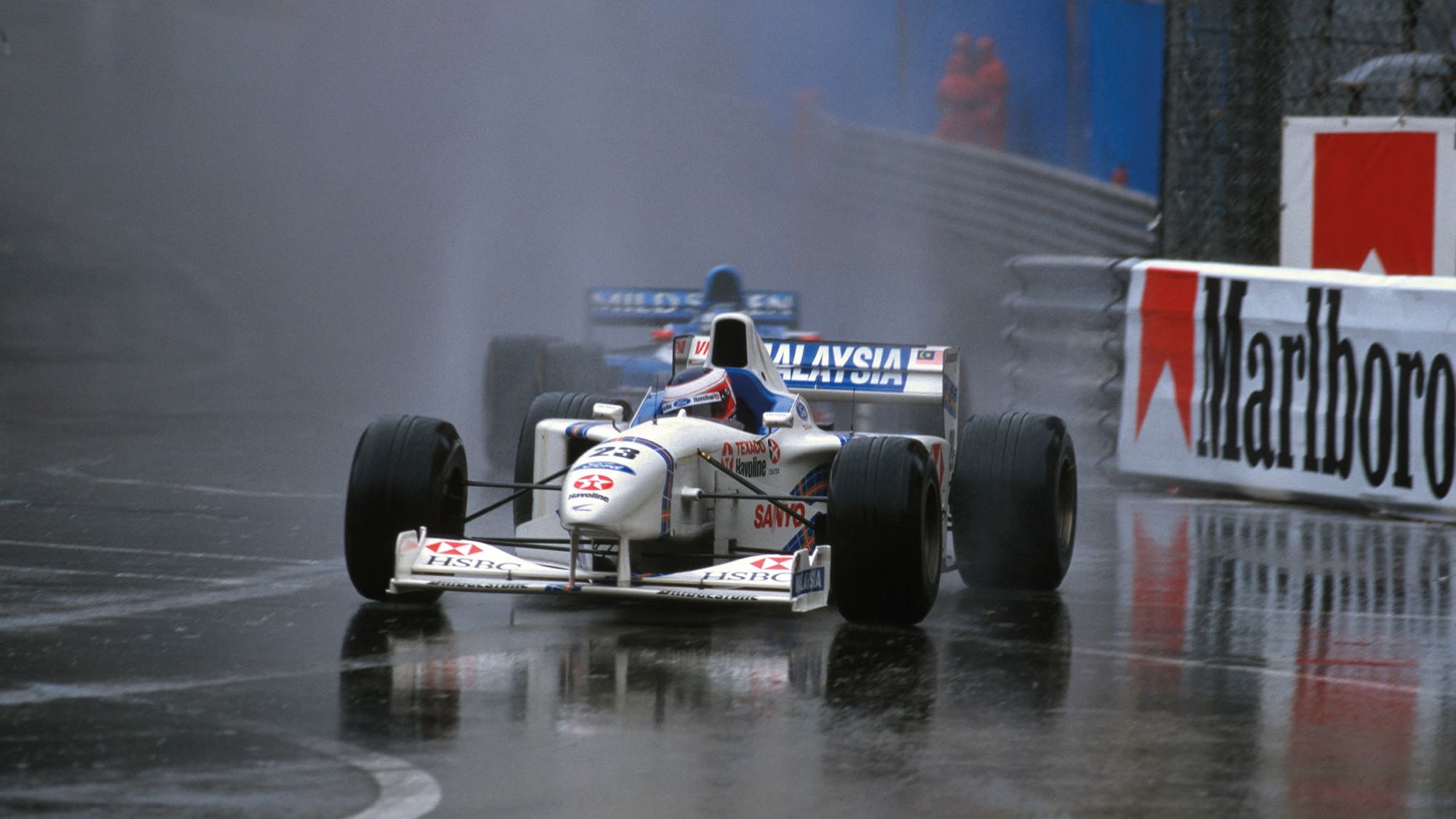
In the wet of the Monaco GP in 1997 Magnussen finished seventh but at Stewart storm clouds were gathering
Grand Prix Photo
It’s a good thing you didn’t quit because you rebuilt your career in spectacular fashion, starting with Panoz in America where you and David Brabham had success.
JM: “I felt so much better as soon as I got to America. It was right for me. I’d always enjoyed the way they go racing there, and I was immediately happy with the team. First I had to put Formula 1 completely out of my mind. I hadn’t realised how unhappy I’d been there, and I wasn’t going back. Kevin feels the same way now. He’s incredibly excited and motivated by getting into those big, powerful, noisy sports cars and loves driving them. Anyway… it was David Sears who put me in touch with the Panoz GT1 programme, run by Tony Dowe, so I went and did a test. I immediately fell in love with the car. It was a little bit weird, with a front engine, like a Batmobile, and it sounded amazing, a real monster. It took a while to get used to sitting so far to the rear, but the test went well, I was fast, and Don Panoz offered me a deal right there for 1999. I went back to Denmark, packed my bags, and moved to America within a week.
“Sometimes it’s great being the underdog. We didn’t beat the Audis and the BMWs on a regular basis, but we did beat them a few times and those were such massive wins. I loved it, these were proper battles and we had a small team, just 15 people, when Audi had hundreds of guys. Winning again was so good, celebrating all night.”
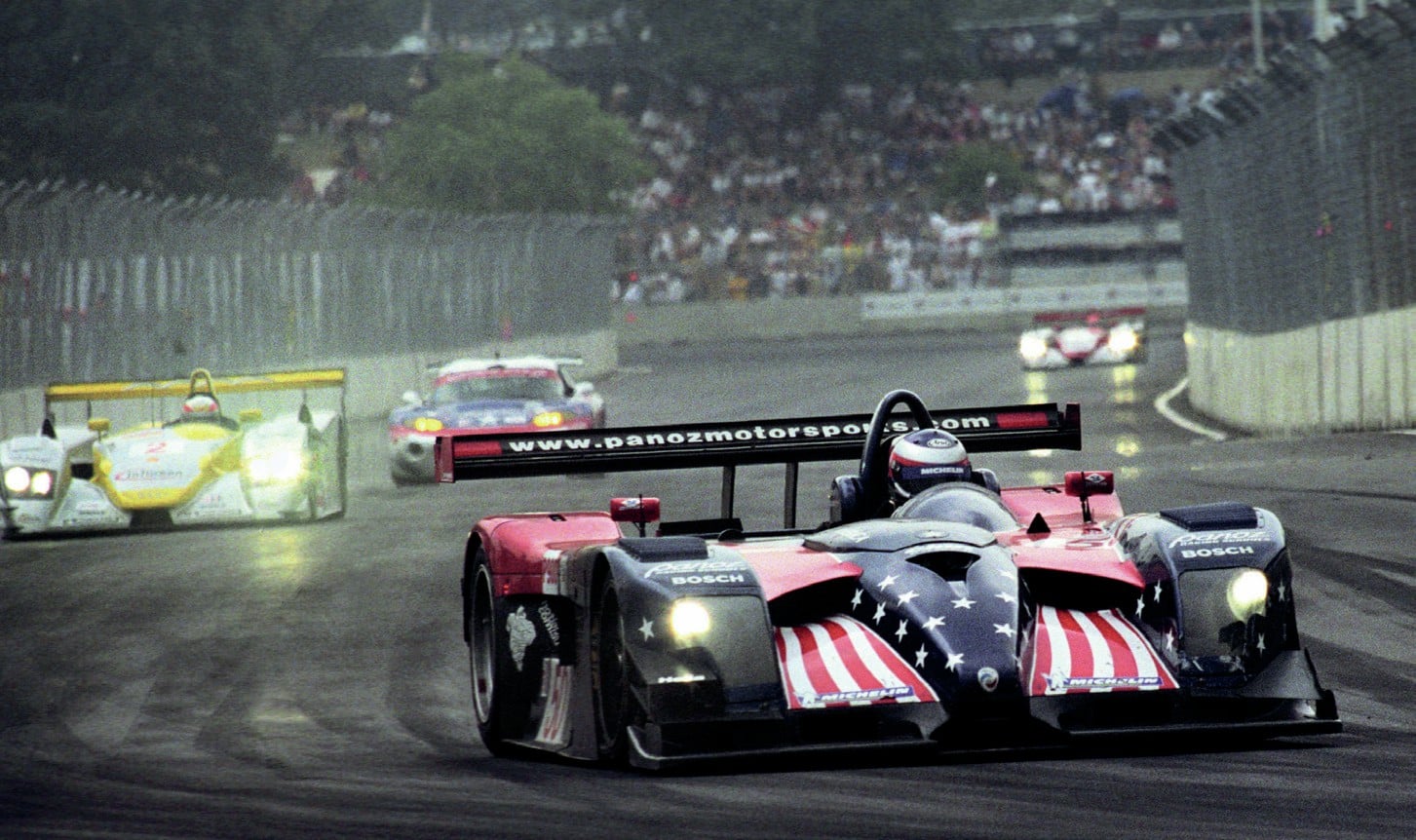
Happier times with Panoz: alongside David Brabham, Magnussen was winning once again
Joel Richardson/The Washington Post via Getty Images
Tell me about the partnership with David Brabham. It seemed like a match made in heaven, the two of you combining your skills to keep the opposition on their toes.
JM: “Oh, yeah, absolutely. He is a very technical driver, super smart, very analytical in everything he does, totally honest, and he has a calmness about him that he works on – to his advantage I have to say – and he’s one of the guys I have learnt the most from in my career so far. In the beginning we were complete polar opposites, but we had a lot of fun with the team, and over time I learnt a lot about myself as a driver and as a human being from him.
“By the end of 2002 we were all pushing Don Panoz to put the engine in the right place, and he kept refusing. He didn’t want to do that, and he asked us, ‘Have you ever seen the horse push the cart?’ He did build a new car but it was a dud and anyway the engine was still in the front. So, going towards 2003, David and I started negotiating a new contract and in our first meeting we had a big list of things we wanted to change. Well, I guess we caught him on a bad day, because within 15 minutes we were back outside and a bit disillusioned. We sensed he wanted to close down the team so now it was time to look for new opportunities.
“You know, Don Panoz was kind of a weird guy, but weird in a good way, a complete original. I will always remember one race at Sebring where I’ve had five class wins. It was so incredibly hot and I’d always struggled with the heat in these front-engined cars, the exhausts running alongside you, and at the end of my first stint at Sebring that weekend the car was like an oven. I came out of the car, I was boiling, glowing red, so I took my overalls off and Don Panoz comes along, looks at me, and says, ‘ You should put some sunblock on that.’ Well, I can laugh about it now.”
After the Panoz years you raced various different cars in long-distance events, catching the attention of Doug Fehan who ran the Corvette Racing programme. Incredibly, you stayed with Corvette for 16 years but how did such a relationship begin?
JM: “To make a long story short, I’d driven for Riley & Scott and for Prodrive in America, and a one-off at Le Mans in a Japanese-run Audi R8 with some good results and then the call came from Corvette. Doug Fehan said to me, ‘Jan, I think we’d both benefit if you come and drive for us rather than against us,’ but they were super-loyal to their existing drivers so it was three years before I joined.
“I became so embedded with the brand that I stopped getting any other offers, but it was a fantastic time and those cars are so cool to drive. We had some great battles with Prodrive in the GT1 car, and with Porsche in the States, really proper racing, and I was enjoying the endurance drives by then. It had taken time for me to get my head round racing for 12 hours and 24 hours, it’s a different skill, going hard but saving the car. I didn’t like these long races to begin with, thought they were a pain in the butt. It was only when I drove the Panoz LMP1 across the line at my first Le Mans in ’99 that I felt the satisfaction of getting to the end and seeing how much it meant to all the guys who’d worked so hard. We were nowhere, way down in 11th, but right then I appreciated what it’s all about, this endurance racing. It’s a team effort and, when it goes right, all that work is very rewarding.”
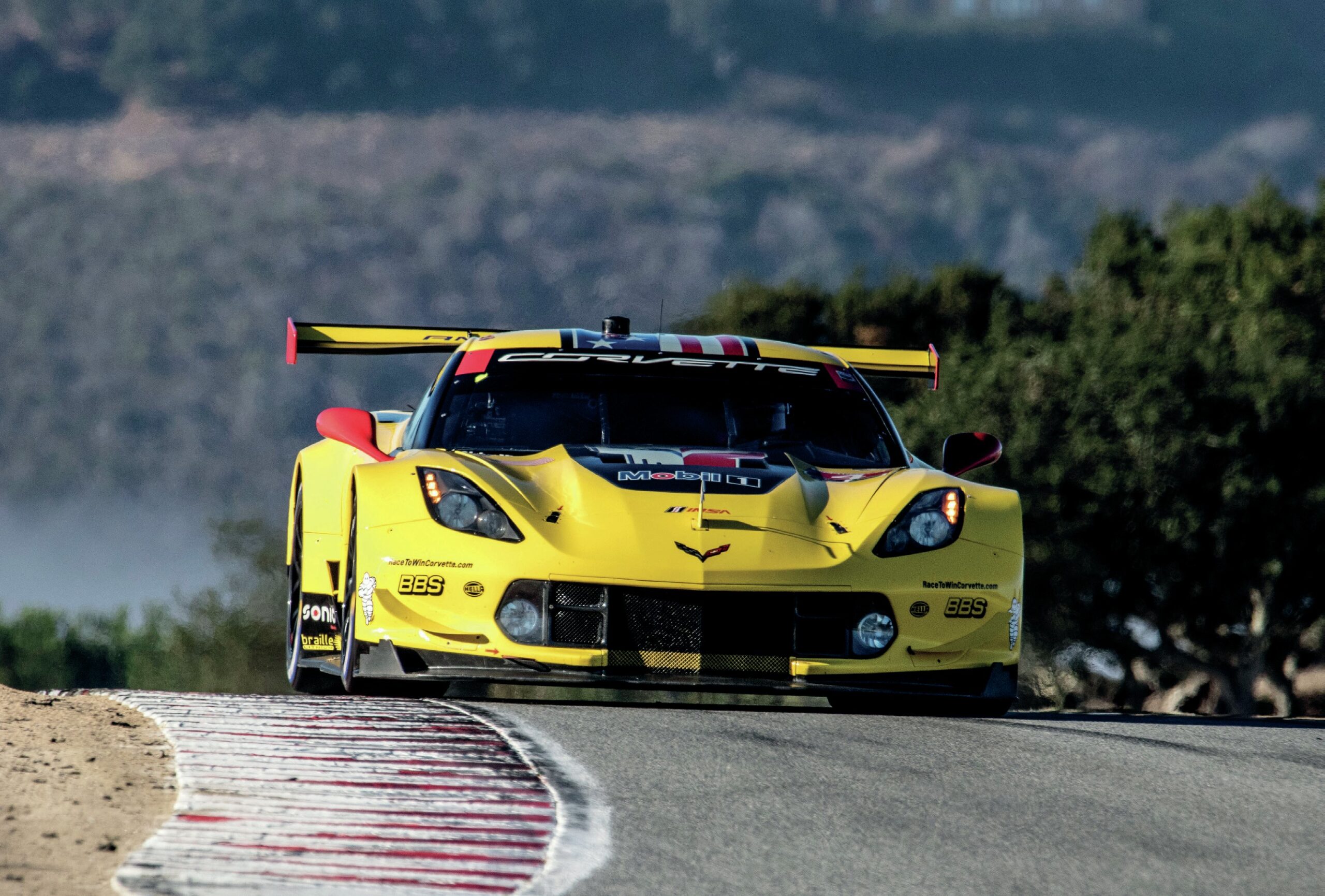
Practice in the Corvette C7.R at Laguna Seca in 2018; Magnussen spent six seasons with Corvette Racing in the US
Brian Cleary/Getty Images
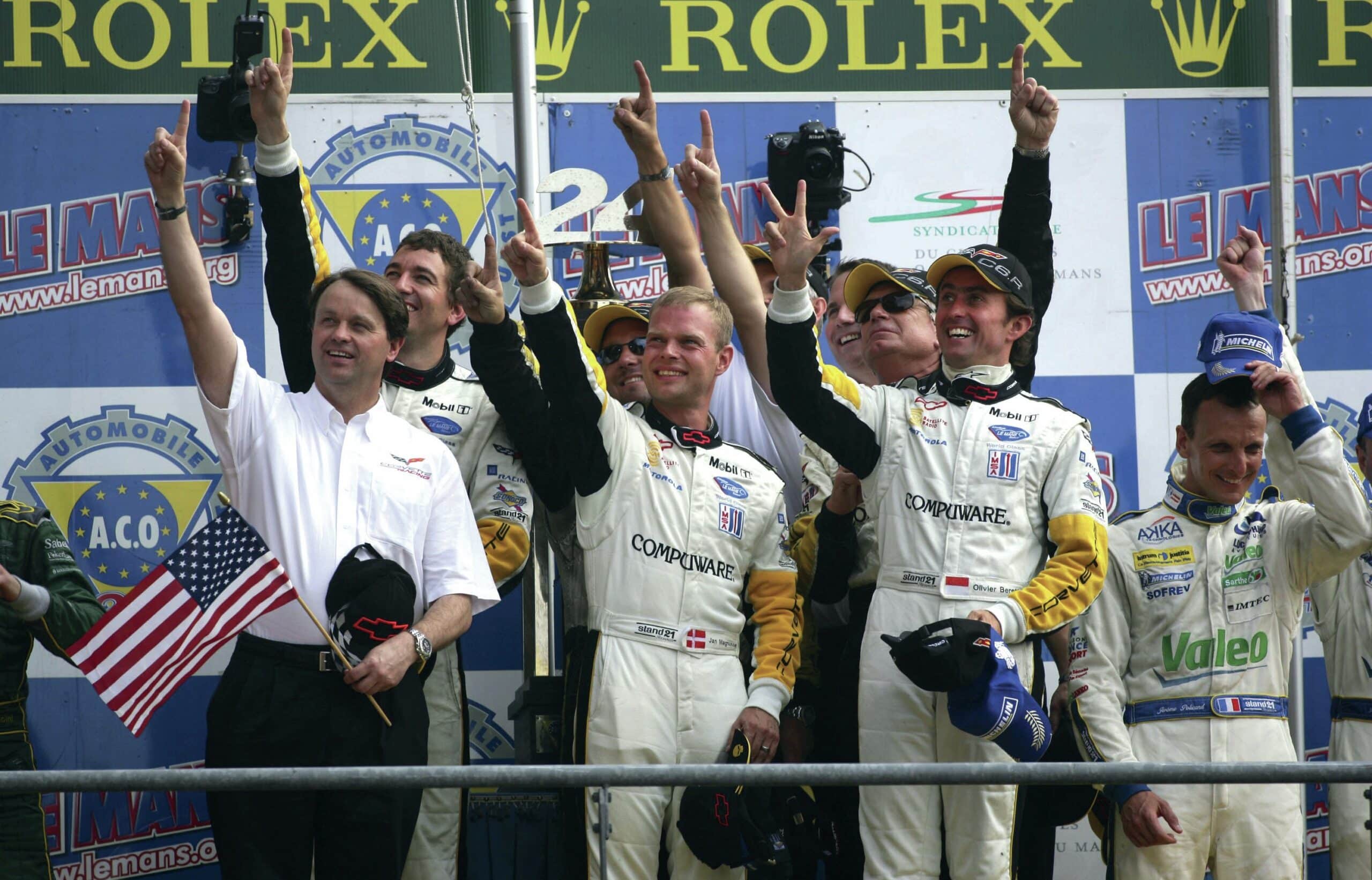
A class win for Magnussen, centre, and Corvette at Le Mans 2006
John Marsh/Getty Images
Motor racing needs gifted mavericks and you are one of those – someone who enjoys racing great cars. Having proved yourself before and after Formula 1, are you in a good place as you start another season?
JM: “Yes, you might be right but I like to win, I like a battle. This year will be my 23rd Le Mans, racing the High Class Oreca 07 Gibson in LMP2 with an all-Danish team this season. I’ll be sharing with Anders Fjordbach and Dennis Andersen so it really is Team Denmark and that’s nice.
“My first laps in the car, in Bahrain, felt really good. It drives very like an Audi R8. The racing in LMP2 is close so I’m looking forward to it. I don’t know how much longer I will keep racing but I do know that I will stop when I am not fast enough, when it’s not fun any more. As long as I’m part of the fight I will keep going. Meanwhile life is good here in Roskilde, a place with some great racing history. Stirling Moss won the Danish Grand Prix here in 1961 and more recently, when Stirling read that he’d always been Kevin’s great hero, he invited him to lunch, told him all the old stories of racing here.
“Right now we’re all at home for a while and I’m going karting with my 11-year-old son Luca today. So, yeah, there’s lots of good life after Formula 1.”
